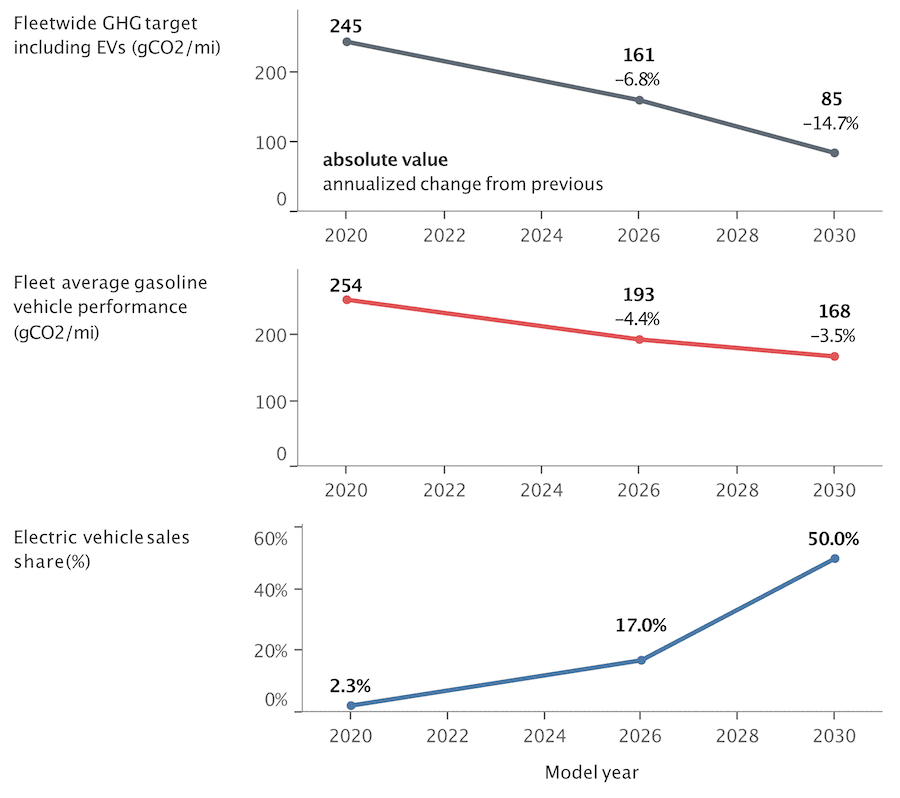Efficiency technology and cost assessment for U.S. 2025–2030 light-duty vehicles
Blog
To put the United States on track to reach 50% electric vehicle sales in 2030, cut the greenhouse gas target in half
Will climate provisions in the Inflation Reduction Act be enough to put the United States on track to meet President Biden’s electric vehicle goal? There’s one way to make sure it is: backstop it with stringent greenhouse gas (GHG) standards for passenger cars and light trucks.
Since 2012, the U.S. Environmental Protection Agency (EPA) has set standards to limit the GHG emissions from light-duty vehicles, which includes cars, SUVs, and pickup trucks. Automakers can meet these standards through a combination of making gasoline and diesel vehicles more efficient, utilizing mild hybrid technology, and by increasing sales of battery, plug-in hybrid, and fuel cell electric vehicles (EVs). In the latest revision of the standard released in December 2021, which includes vehicle model years up through 2026, EPA projected that the revised standard would lead to 17% EV sales in 2026.
A 17% percent EV sales share would be a big jump up from today—the U.S. EV sales share was only 4% in 2021 and 7% in the first 6 months of 2022. However, it’s nowhere near President Biden’s goal of 50% EV sales share by 2030.
How do we get from 17% in 2026 to 50% in 2030? It will take a proverbial village of policy actions to drive that large of a shift. Thankfully, many of them are in place already. The aforementioned Inflation Reduction Act extends and revamps existing tax credits for EV purchases and charger installations. The Bipartisan Infrastructure Law, passed in 2021, allocates $7.5 billion to EV charging infrastructure. California’s Advanced Clean Cars II regulations require 100% EV sales in California in 2035, and these regulations will likely be adopted by a number of other states. But even if all the states that adopted California’s earlier ZEV regulation align with its Advanced Clean Cars II update, we estimate that the remaining states would need to reach 38% EV sales share in 2030—a high bar. A key missing policy lever for reaching 50% EV sales in 2030 is regulation that covers the entire country. EPA has the opportunity to deliver this last piece in its upcoming proposal for passenger vehicle GHG standards, expected early next year, for vehicles sold after 2026.
How stringent do EPA’s standards have to be to set us on a path to 50% EVs by 2030? First, it depends on how much efficiency improvement we expect for gasoline cars and light trucks. Automakers have a choice of how to meet EPA’s fleet average standards and can use any combination of efficiency improvement technologies for gasoline vehicles and EVs, namely battery-electric vehicles which are counted as zero emission, to reach their targets.
Based on a previous technology assessment, we estimate that the efficiency of gasoline vehicles will improve at an average rate of 3.5% per year. This is less than the rate of efficiency improvements that would be necessary to meet EPA’s current standards, which we estimate to be 4.4% per year based on fleet average data from EPA’s 2021 fuel economy trends report and the agency’s projection of 17% EV sales share in 2026. Following the annual improvement rate of 3.5%, and using data for EPA’s fuel economy trends report, gasoline vehicles would have an average GHG emissions rate of 168 gCO2 per mile in 2030, compared to our estimate of 254 gCO2 per mile in 2020. This is what we think can be achieved by gasoline vehicles alone, without considering a single EV.
That’s a lot of emissions we’re likely to squeeze from regular old gasoline cars and trucks, which means that to also incentivize getting to 50% EV sales by 2030, EPA will need to cut the GHG standard much deeper. Since most EVs, those that are purely battery electric, count as zero emission, that means roughly halving the gasoline vehicle emissions rate to 85 gCO2 per mile—this is what we think EPA needs to set the light-duty standard at in 2030 to reach President Biden’s goal.

Figure 1. Stringency of model year 2030 GHG targets needed to reach 50% EV sales in 2030
The figure above summarizes the path required from the current standard of 161 gCO2 per mile in 2026 to 85 gCO2 per mile in 2030 for the whole light duty fleet (top panel). As shown, in order to meet the fleet-wide target of 85 gCO2 per mile in 2030, manufacturers will have to reduce emissions by 6.8% annually from 2020 to 2026, and by 14.7% annually from 2026 to 2030. We estimate that efficiency improvements in gasoline vehicles (middle panel) will range from 3.5% to 4.4% annually and will only cover a portion of the required emission reductions. However, the acceleration of EV uptake to 50% of sales (bottom panel) can make up the difference.
When we put this into perspective, reaching 85 gCO2 per mile in 2030 is ambitious, but is achievable and in line with existing standards. Setting the next round of standards at anything higher would risk missing President Biden’s goal and would leave valuable climate benefits on the table.
